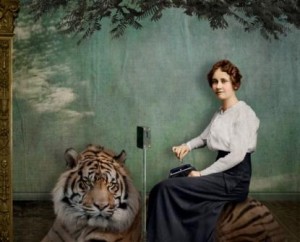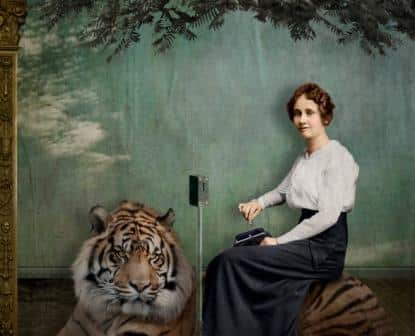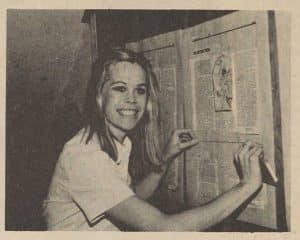 By Aimee Hickman
By Aimee Hickman
The beautiful cover artwork for this quarter’s issue of Exponent II speaks directly to my own emotional state on the eve of what may be an historic General Conference for the LDS Church. Although it was likely not artist Corinne Geertsen’s intent, I see in her painting, “Coin-Op,” an allegory of this particular moment in the long history of Mormon feminism. For me the woman appears as an early twentieth-century Mormon suffragette. Her sly smile and stoic posture as she sits side-saddle suggest a woman whose expectations for what will happen when coin meets machine seem confidently set. I see a woman whose efforts to promote the suffrage agenda, to fulfill the measure of her feminine creation by expanding the possibilities for her sex, have been galvanized into the coin she holds so gingerly in her fingers. She’s ready for the ride. The tiger’s expression is what makes me nervous. Though our lady can predict that her coin will earn her a ride, it’s artfully unclear whether she’s in for a bouncy little jaunt, or a thrill ride that will see her soon abandon her side-saddle pose and have her wrestling the tiger, fully astride.
The parallel between her moment and ours as Mormon feminists is not lost on me. As a Mormon feminist, I can’t help feeling a bit like that woman perched precariously on the tiger’s back, coin in hand, ready for a ride. Never has the time to use this hard-earned currency felt more tempting. Mormon feminism’s emergence as a powerful voice during the Obama/Romney presidential campaign has emboldened our movement in ways and on a scale I would not have thought possible a year ago. Seeing a rising generation of Mormon feminist activists merge with a path that was trail-blazed by previous generations has been exhilarating, nerve-wracking, and thrilling.
The growth of Mormon feminism in the last year has meant engaging in spirited and sometimes dispiriting discussions about what methods, rhetoric, and ultimate goals will best serve a Mormon feminist agenda. As a community, our handling of these discussions hasn’t always lived up to our own ideals. Nevertheless, I feel grateful for a growing community of women who have entered the fray. I feel gratitude to my foremothers who have laid a groundwork that has helped a new generation of Mormon women find a community in the midst of their own feminist awakenings. I feel grateful to that new generation and the boldness of their ideas and actions that are contributing to a great Mormon feminist tradition. Each of us who has written an article, or read a blog post, or made a Facebook comment, or shared our struggles in church, or silently sought out other voices in our own loneliness, has earned a coin for this ride.
But at the end of the day, we can’t really know what our coin will purchase. Will this tiger reward our efforts with the thrill we seek, putter out after 10 seconds, or race off out of control, leaving us in a heap? Unlike most democratic social movements, the changes we seek in the Church can’t come about just by swaying public opinion. The LDS Church is an institution—a machine all its own. The cogs and gears are individuals within that structure who direct the entire mechanism with their unique interpretations of God’s will. Yet the membership as a whole provides a metaphorical shot of WD-40 to move those directives forward or slow them down. And that is where Mormon feminism is doing so much good.
I don’t know if this weekend’s ride will reward Mormon feminists with an exhilarating thrill or an “out of order” message, but I’m dropping my coin in the slot anyway. I hope that however the ride goes this weekend, we can all find a way to come back on Monday and say “again, again!”There’s no one I’d rather be on this ride with than all of you.
Aimee Hickman is Co-Editor of Exponent II. She lives in Baltimore, MD with her husband and three coin-op ride-loving children.





